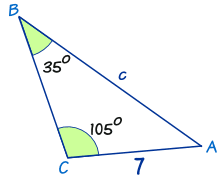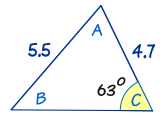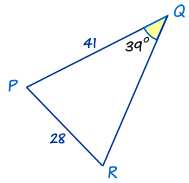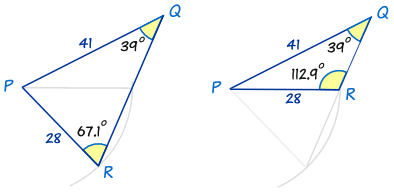قانون جيب الزاوية
قانون جيب الزاوية
The Law of Sines (or Sine Rule) is very useful for solving triangles:
asin A = bsin B = csin C
It works for any triangle:
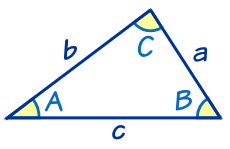 |
a, b and c are sides.
A, B and C are angles.
(Side a faces angle A,
side b faces angle B and side c faces angle C). |
And it says that:
When we divide side a by the sine of angle A
it is equal to side b divided by the sine of angle B,
and also equal to side c divided by the sine of angle C
it is equal to side b divided by the sine of angle B,
and also equal to side c divided by the sine of angle C
Sure ... ?
Well, let's do the calculations for a triangle I prepared earlier:
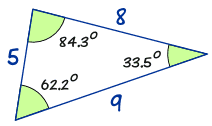 |
asin A = 8sin(62.2°) = 80.885... = 9.04...
bsin B = 5sin(33.5°) = 50.552... = 9.06...
csin C = 9sin(84.3°) = 90.995... = 9.05...
|
The answers are almost the same!
(They would be exactly the same if we used perfect accuracy).
(They would be exactly the same if we used perfect accuracy).
So now you can see that:
asin A = bsin B = csin C
How Do We Use It?
Let us see an example:
Finding an Unknown Angle
In the previous example we found an unknown side ...
... but we can also use the Law of Sines to find an unknown angle.
In this case it is best to turn the fractions upside down (sin A/a instead of a/sin A, etc):
sin Aa = sin Bb = sin Cc
Sometimes There Are Two Answers !
There is one very tricky thing we have to look out for:
Two possible answers.
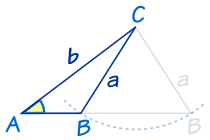 |
Imagine we know angle A, and sides a and b.
We can swing side a to left or right and come up with two possible results (a small triangle and a much wider triangle)
Both answers are right!
|
This only happens in the "Two Sides and an Angle not between" case, and even then not always, but we have to watch out for it.
Just think "could I swing that side the other way to also make a correct answer?"
But wait! There's another angle that also has a sine equal to 0.9215...
The calculator won't tell you this but sin(112.9°) is also equal to 0.9215...
So, how do we discover the value 112.9°?
Easy ... take 67.1° away from 180°, like this:
180° - 67.1° = 112.9°
قانون جيب الزاوية
![قانون جيب الزاوية]() Reviewed by . blogmathappily
on
2:16 م
Rating:
Reviewed by . blogmathappily
on
2:16 م
Rating:

